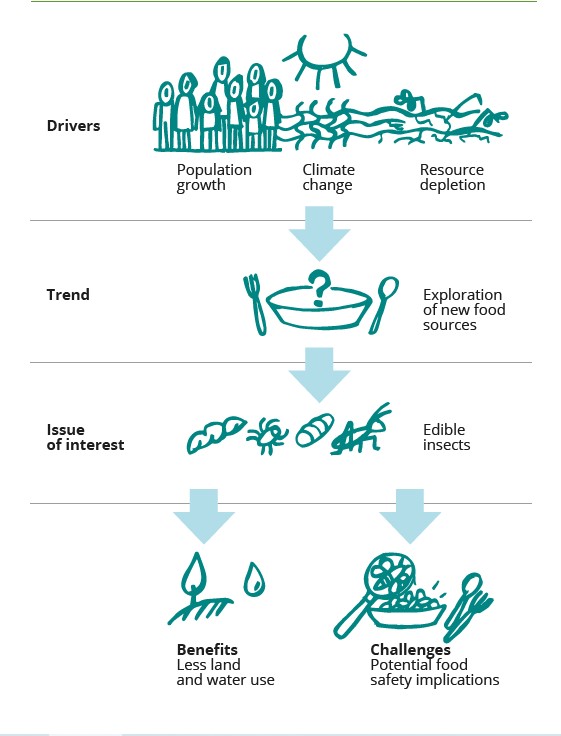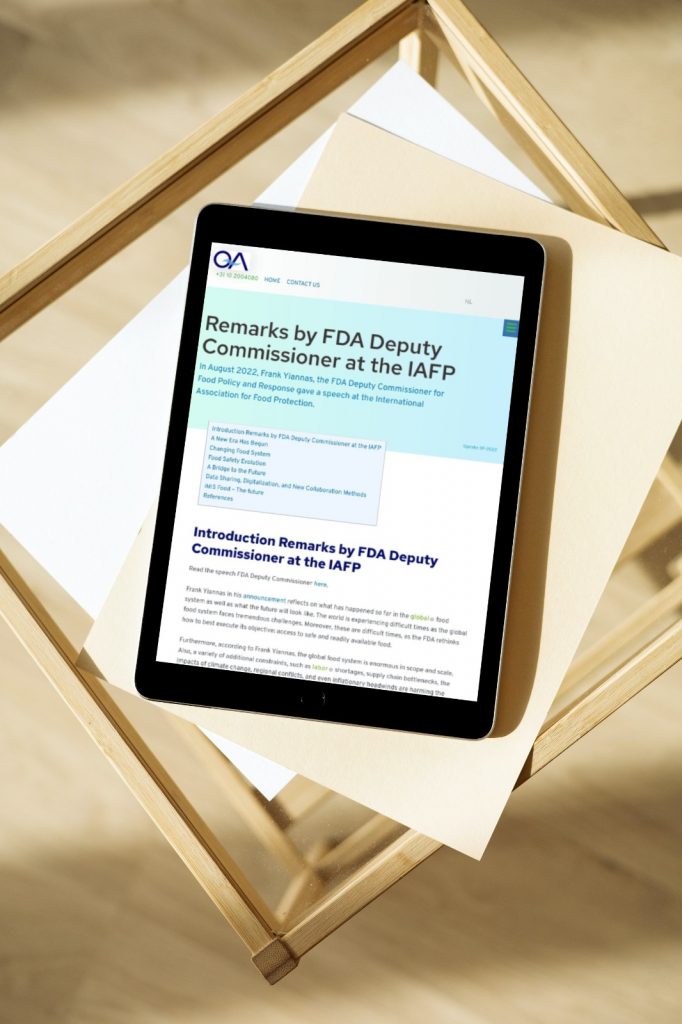Introduction to the future of food safety by FAO
The goal of the FAO food safety foresight program is to identify, evaluate, and rank emerging trends and drivers in and around agrifood systems that can affect food safety. Thus, this will lead to better strategic planning so that possible risks can be handled better and new opportunities can be taken advantage of.
The world’s population is set to reach 9.7 billion by 2050 (UN, 2019), thus there is more pressure on agrifood systems to feed everyone (FAO, 2018). Furthermore, there are less than 10 years left to reach the 2030 Agenda (UN, 2015). Changing agrifood systems is crucial to reaching the Sustainable Development Goals (SDGs).
The FAO report looks at some of the most important drivers and trends that the FAO’s food safety foresight program has found.
Agrifood systems
Agrifood systems contain the various dynamic and interconnected phases of agricultural production, processing, distribution, and consumption. Each phase involves a number of processes, value chains, players, and interactions. To combat poverty, safeguard human rights, and restore ecosystems, the United Nations emphasizes the importance of resilient agricultural methods and sustainable food production systems. Food safety is one of the main components of this system.
“Food safety is everyone’s business”
FAO and WHO, 2021
Thus, the focus is on chaining agrifood systems so that they are more resilient, sustainable, as well as fair in the face of today’s challenges. This aims to ensure that the growing population has access to healthy, safe, and affordable food.
Drivers

Agrifood systems are changing to meet the 2030 Agenda. Because of this, foresight methodologies enable the identification of emerging drivers and trends that have consequences for the systems as a whole and for food safety, which is a major element of agrifood systems. Figure 1 illustrates these trends and drivers.

Figure 2 looks at the relationship between drivers and trends, using the use of insects that can be eaten as an example.
Climate change and food safety impacts
Weather events are becoming more common, severe, and unexpected as a result of climate change. Such disasters not only have an effect on security by reducing agricultural productivity, yield and disrupting supply chains, but they also have an impact on food safety.
Increased temperatures, severe droughts, heavy rains, soil quality degradation, rising sea levels, and ocean acidification, have a serious impact on various biological and chemical contaminants in food. These factors influence their virulence, occurrence, and distribution. As a result, it is more likely that foodborne hazards will be encountered. Furthermore, the increased globalization of food supply chains leads to a rise in foodborne hazards along the path. Therefore, minor foodborne occurrences become international.
Moreover, it is estimated that approximately 14 percent of food produced is lost before it reaches the retail level or the consumers. Food contamination issues play a role in this loss (FAO, 2019). Additionally, climate change can worsen the situation by creating conditions that make foodborne hazards more likely to emerge and spread.
Unsafe food is not fit for consumption. The impacts of climate change on food safety will hinder efforts to attain food security in the face of a growing global population and an increasing demand for food. Food security requires sufficient, affordable, nutritious, and safe food.
A way forward
Therefore, it is critical that food supply chains and regulatory institutions are better prepared to react to the rising implications of climate change on food safety. Some critical components for preventing and controlling foodborne outbreaks, especially in climate-vulnerable countries are extensive early warning systems, monitoring, and surveillance techniques.
Changing consumer preferences
Consumer behavior is changing as a result of a variety of issues. Some include climate change, a focus on improving health, environmental sustainability, and rising incomes. Additionally, there may also be food safety issues that come along with these changes.
Moreover, the food industry is also emphasizing trustworthiness and authenticity, with consumers expecting greater transparency regarding the carbon footprint of their food products, as well as a greater focus on responsible sourcing of food ingredients, simplifying food labeling, and addressing concerns about food safety.
Food safety implications
Some of the food safety implications to be considered are food allergens, the popularity of functional foods, and online purchasing.
For instance, a study on home-delivered meal kits discovered a number of issues that raise food safety concerns, such as insufficiently cold packaging, improper storage, or crushed packages causing cross-contamination. Additionally, insufficient and frequently inaccurate food safety information is present on websites, implying that customers may struggle to obtain appropriate food safety information (Hallman, Senger-Mersich, and Godwin, 2015).
Action to be taken on food safety
The food safety risk assessments will need to keep up with changes in consumer preferences and demands in order to protect consumers.
Furthermore, online sources can be valuable tools for engaging and educating consumers about food safety. Yet, the online environment can also expose consumers to a lot of inaccurate or fake information. Nevertheless, technological innovations will be of great assistance in keeping pace with changes in the food sector. Thus, this is obtained by identifying emerging allergens and contaminants in new food sources, establishing appropriate standards, and developing adequate risk management systems.
New food sources and food production systems
To improve the health of the environment and the nutritional value of food, scientists are looking into new food sources and ways to make food. This paper analyzes the consequences for food safety of farming edible insects, jellyfish, seaweed production, plant-based alternatives, and cell-based food production.
Food safety considerations for urban agriculture
Urban agriculture is on the rise in response to the expanding urban population. Up to 70 percent of all food produced worldwide is consumed in urban areas (FAO, 2020).
Urban food systems must evolve due to shifting demographics, maintaining food security, growing food choices, health concerns, and climate change. Therefore, there is a need for greater commitment to urban agriculture issues.
Advantages and disadvantages
As with other food production systems, urban food systems must consider food safety along the entire supply chain. Urban farming offers both advantages and difficulties in terms of food safety. Among these benefits are increased traceability and fewer food miles, which help prevent food spoiling and, thus, reduce food loss.
Furthermore, indoor urban farms can eliminate foodborne illness hazards posed by wildlife. Thus, this leads to gaining access to crops and reduces the increasing unpredictability of weather due to climate change.
However, some food safety challenges need to be considered, such as soils, chemical hazards, water sources, air pollution, and animal husbandry.
Technological innovations and scientific advances
Technological advances make it easier to track food supplies and find pollutants in food. Moreover, they have also made it possible to use advanced predictive analytics to identify possible risks and find pollutants in food.
The food industry is evolving rapidly in terms of food packaging, new technologies (like nanotechnology), and new techniques for producing food (like 3D printing). However, all require rigorous assessments of the advantages and risks they present in terms of food safety.
Nonetheless, the application of automation, AI, big data, and blockchain technology has the potential to improve food safety management. Yet, it can also raise concerns about data privacy and access. Additionally, scientific developments will inevitably change how risk assessments are done for food safety. Therefore, it is crucial for both food safety and trade that the world community is prepared to pursue such developments.
Food fraud
Food fraud is a complicated issue that leads to strong reactions from consumers and may affect the safety of food. The goal of this foresight brief is to highlight the idea of increasing awareness and building trust in food control systems.
Nowadays, food fraud is on the rise due to people taking advantage of complicated agrifood systems. Therefore, resilient agri-food systems are needed in order to mitigate food fraud.
The article gives an overview of the regulatory approaches that can be used to fight food fraud and maintain confidence in agrifood systems.
Conclusion
As people transform how food is produced, distributed, and consumed, there is a need for effective and proactive food safety management. This needs to keep up with the shifting global context to ensure food safety-based vigilance throughout the agrifood systems. As a result, the use of foresight in food safety has never been more important.
- ‘’Foresight plays an important role in identifying emerging food safety challenges and opportunities that will continue to arise as the global context evolves with the ongoing transformation of the agrifood systems.
- Foresight will enable emerging issues to be looked at through a food systems lens by encouraging a holistic way of evaluating both opportunities and challenges that can have varying impacts on food safety and, through it, on agrifood systems.”
Sources
- FAO. 2022. Thinking about the future of food safety – A foresight report. Rome. https://doi.org/10.4060/cb8667en
- FAO. 2018. The future of food and agriculture – Alternative pathways to 2050. Rome. https://www.fao.org/3/I8429EN/i8429en.pdf
- FAO. 2019. The State of Food and Agriculture. Moving forward on food loss and waste reduction. Rome.
- FAO. 2020. Cities and local governments are at the forefront in building inclusive and resilient food systems. Key results from the FAO survey “Urban Food Systems and COVID-19”. Rome. https://www.fao.org/3/cb0407en/CB0407EN.pdf
- Hallman, W.K., Senger-Mersich, A. & Godwin, S.L. 2015. Online purveyors of raw meat, poultry, and seafood products: Delivery policies and available consumer food safety information (Review). Food Protection Trends, 35(2): 80–88.
- UN. Department of Economic and Social Affairs, Population Division. 2019. World Population Prospects 2019: Highlights. New York, USA, UN. https://population.un.org/wpp/Publications/Files/WPP2019_Highlights.pdf
- UN. 2015. Transforming our world: the 2030 Agenda for Sustainable Development. Resolution adopted by the General Assembly on 25 September 2015. Seventieth session. https://www.un.org/ga/search/view_doc.asp?symbol=A/RES/70/1&Lang=E
Related articles to The future of food safety, a foresight report by FAO
Many customers and visitors to this page 'The future of food safety, a foresight report by FAO' also viewed the articles and manuals listed below:



